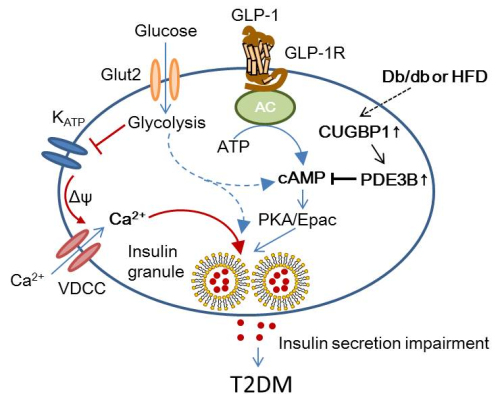Research reveals a novel negative regulator of insulin secretion
Type 2 diabetes mellitus (T2DM) is a chronic metabolic disorder that is characterized by high blood sugar, insulin resistance, and relative lack of insulin. Over the past decades, a continuous prevalence of T2DM has been observed in both developing and developed counties. This phenomenon is much more common in China. According to the latest data, 10% of Chinese adult have diabetes. It is estimated that about 114 million people (about a third of all people with diabetes in world) are affected by T2DM in China. Thus, it is urgent to define all the factors involved in this disorder.
Insulin, the only hormone capable of lowering blood glucose levels, is secreted by β cells of the islets of Langerhans. As shown in the Figure, glucose as well as several hormones are able to stimulate insulin secretion in a Ca2+ dependent or independent manner. In T2DM, glucose or hormones stimulated insulin secretion is usually impaired. Thus, it is very important to determine the factors contributing to the impaired insulin secretion.
In a new study published in Diabetologia, entitled RNA-binding protein CUGBP1 regulates insulin secretion via activation of phosphodiesterase 3B in mice, researchers from both Chinese Academy of Sciences and Université Paris-Sud reported a novel regulator of insulin secretion.
CUGBP1 is a multifunctional RNA-binding protein and regulates various RNA processes including translation, deadenylation, and alternative splicing, as well as RNA stability. In this study, Zhai et al. found that CUGBP1 was overexpressed in the islets of diabetic mice. With CUGBP1-overexpression and knockdown mice, they demonstrated that CUGBP1 negatively regulates insulin secretion both in vivo and in vitro.
In a mechanistic analysis, they showed that cAMP but not Ca2+ was involved in the CUGBP1-mediated insulin secretion impairment. Further studies showed that CUGBP1 can negatively up-regulate PDE3B not the other PDE isoforms. This regulation was achieved through binding to the 3'-UTR of PDE3B and mobilizing its mRNA stability.
This study reveals a novel regulator of insulin secretion as shown in the Figure. As CUGBP1 is overexpressed in the islets of diabetic mice, the repression of CUGBP1 might provide a potential strategy for the treatment of type 2 diabetes.
The work was funded by the 973 Program of the Ministry of Science and Technology and the National Natural Science Foundation of China.

Role of CUGBP1 in insulin secretion (Image by IBP)
Contact
JI Guangju
National Laboratory of Biomacromolecules, IBP,CAS
Tel:010-64846720
E-mail:gj28@ibp.ac.cn

